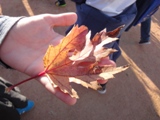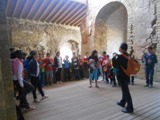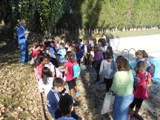TRIP TO ISÀVENA-CANELLES -6è
Last Thursday, 26th March, Primary 6th pupils went on a school TRIP TO ISAVENA VALLEY, a tributary river of Éssera river. Both rivers feed Barasona dam, the origin of Aragon and Catalonia canal.
We visited the impressive medieval Capella bridge and the wonderful medieval village of Roda d'Isàvena.
In the afternoon, we visited Canelles hydroelectric power station, the pharaonic dam and the incredible stalactite-stalagmite gallery called the Black Cave.
It was a wonderful excursion and pupils enjoyed it very much.
Thanks a lot to Almacelles Town Council and Venso Group for making it a completely free school trip.
PARK OF EUROPE EXCURSION
Last Wednesday, 19th November, Primary 6th pupils accompanied by their classroom teachers and the English-science teacher went to visit Park of Europe on its scientific aspect:
- Planetarium: particular characteristics of planets and proportional distances
- Most important characteristics of the trees planted in the park; English, Catalan and scientific (Latin) names, historical significant features related to important historical characters or facts.
We left school together al 15:00, walked down Catalonia and Generalitat Avenues and commented on the trees we will found on the route: a tall and old Mediterranean cypress, a large and beautiful Chinaberry tree (Melia azedarach), a nice magnolia tree an all the Avenue’s plane trees.
A bit later we stopped in front of Jordi Giribet’s house in High Street where we could see the tall and wonderful coast redwood (sequoia sempervirens).
Before entering the park we saw the Lambert cypresses in front of the entrance door, by the lord’s palace balcony.
In the park we studied red robin fhotinias, lavender bushes, silver maples, oriental thujas, weeping willows (salix babylonica), Himalayan cedars, Atlas cedars, silver firs, Colorado firs, and finally the stars of the excursions: giant redwoods (sequoia giganteum) and cost redwoods (sequoia sempervirens).
To finish the excursion we explained the Planetarium: differences between terrestrial planets and gas giants, characteristics of each one, scientific size scale (the rocky or terrestrial planes are made 2 times bigger than in space, in order to be visible), relative scientific distances (scale:1 cm in the park =2 million km in space).
It was a very useful excursion and after finishing the revision in the classroom, pupils will have an exam in English. Every activity was done in easy English.
The classroom and English-science teachers
MONTSEC OBSERVATORY EXCURSION
On Friday, 30th October, at 8:00, 51 Primary 6th pupils, their classroom teachers, Tomàs, Jesús and Rosa and their English-Science teacher went on an excursion with four important aims: Avellanes monastery, Àger (cultivation field) medieval village, Saint Peter church-castle and Montsec (cut mountain range) Observatory.
We had worked very hard the four goals at school in English-Science classes, so the development of the trip was very quick and easy.
At Avellanes (hazelnuts) monastery (9:15-11:00) we explained the importance of monasteries in medieval times: opening new fields and innovating agriculture, copying old Roman texts and reinforcing the re-conquered territories defences. We explained them the characteristics of Romanesque style (cloister), Gothic style (temple) and Renaissance-Neoclassical style (entrance). We showed them the different characteristics of the interesting trees around the monastery: hackberry trees, cedars, firs, cypresses, oaks, jujubes.
In Àger (11:30-13:45) we divided the pupils into two groups and two guides explained the medieval village and Saint Peter church-castle. Pupils know in situ about two of the most important Lleida historical characters: Arnau Mir de Tost, conqueror of Àger and founder of Saint Peter, and Gaspar de Portolà, (we saw his grand parents house) the conqueror of California.
We had lunch by the observatory, we celebrated “Castanayda” and from 15:30 to 17:30 the same groups as in Àger with two more guides we saw the evolution of stars in the Planetarium and they opened the dome (semi spherical roof) of the Planetarium and we could observe the sun flares and stains projected on a screen. The guide showed the pupils how telescopes work when observing the sun.
We had an easy return trip and we got to Almacelles at 19:00, as programmed.
Pupils came back a bit tired, but very happy with the excursion.
HALLOWEEN`14
Last Wednesday spooky witches, ghosts and vampires visited Antònia Simó i Arnó.
We played with them “TRICK OR TREAT” and they gave us lots of sweets.
We wish you a HAPPY HALLOWEEEN
5èA
5èB
MUNICIPAL SWIMMING POOL GARDENS OBSERVATION
On Wednesday, 22nd October, pupils of Primary 5th went to observe the many different species of ornamental trees and bushes in the MunicipalSwimmingPoolGarden with their classroom teachers, Mercè and Imma, the experimental science teacher, Pilar Gascón, and the school environment coordinator, César.
The environment coordinator, with the inestimable help of Pilar Gascón and Ignasi Comella at the important moments of identification, had prepared an accurate power point presentation with many pictures, short explanations of the characteristics of those trees and bushes, and their English, Catalan and scientific names.
Pupils had four different sessions in their English or Science classes to prepare the scientific excursion. The projection of the power point was a very useful and motivating teaching material.
On the way to the Swimming Pools we observed the different trees we found in the streets, present too in the gardens to visit, to encourage their scientific curiosity and observation attitudes.
When we got to the Swimming Pools they could identify some of trees that had already seen on the power point projection or in the street observation with not much difficulty.
We worked mainly to identify the different types of coniferous trees or bushes in the gardens, by focussing on the similarities and the differences to discover the way to approach to scientific identifications.
The coordinator prepared too some computing activities to exploit the contents of the excursion and to make easier to remember the names of plants associated to clear pictures of the most typical characteristics of any type of tree or bush.
It was the first time that ENGLISH was used to develop this observation activity. Teaching materials, explanations and testing materials are in English, with the support of Catalan names. It has been a quite reasonably encouraging and successful activity.
Our school will develop all the excursions about environment in Primary 3rd cycle in English, in coherence with the fact of teaching pupils of this cycle some sessions of science in English.




